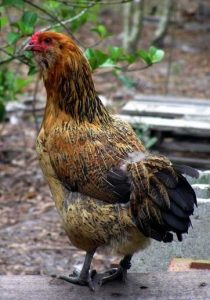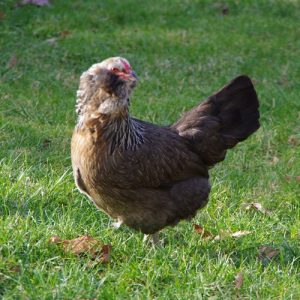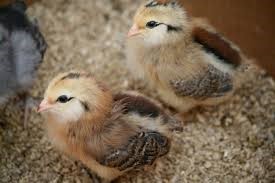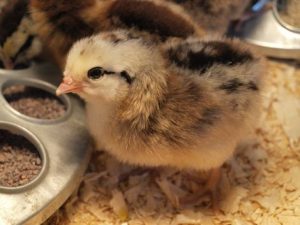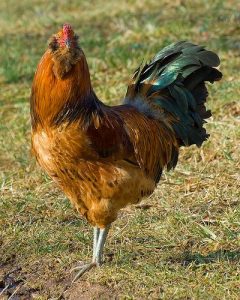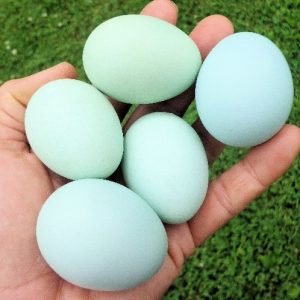
Ameraucana Breed Intro
The American bred chicken that lays wonderful blue eggs!
A multi-colored bearded chicken, generally noted for its calm and docile temperament, although some can be somewhat ‘jumpy’ or flighty and easily disturbed, particularly if not used to being picked up.
Ameraucanas are medium sized birds who are quite hardy and good at surviving cold weather for short spells. Currently ten different colors of Ameraucan chickens exist, but the ‘Splash’ color is not yet officially recognized by The American Poultry Association.
Developed in the USA during the 1970s using carefully selective breeding with Araucana chickens imported from Chile, South America and accepted by The American Poultry Association in 1984. Ameraucana are dual purpose eggs and meat chickens, with hens laying blue/azure shelled eggs, often up to 200 per year if well cared for. Ameraucana hens are noted for having a very long laying season!
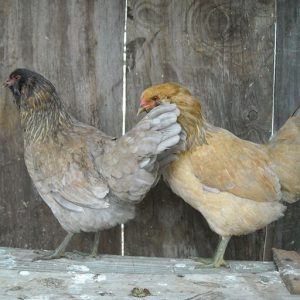
Their blue eggs owe their color to a pigment called oocyanin that permeates the eggshell so that both the inside and the outside of the shell are the same shade of blue. Available as both standard and bantam sized chickens. True Ameraucana chickens have 2 copies of the blue egg gene.
Confusingly, hybrids of this breed called Americauna or Americana (carrying only one copy of the blue egg gene) are nicknamed ‘Easter Egg Chickens or Easter Eggers’. This is due to their green and blue eggs looking just like Easter Eggs. Easter Egg Hens, depending on individual breeding line, can lay eggs in a wide variety of colors including brown, pink, blue, green, yellow and sage.
The name Ameraucana is a mix of the two words “American” and “Araucana.” The Araucana chicken unfortunately has two lethal genes, one for taillessness and the other for tufted ears. Sadly, if a chick inherits either gene from both parents, it will usually die before hatching.
Breed History
Mr. Keller of Pratt Experimental Farm in Pennsylvania USA began working with Araucana chickens in 1925. He wanted to produce chickens that would lay the same pretty blue eggs as the Araucana, but without its lethal genes. Mr Keller thus crossed Araucana chickens with several different breeds of chicken to eliminate the undesirable genes.
By 1970, chicken breeders had successfully developed a chicken that had blue eggs and didn’t have genes for taillessness or tufted ears. Blue Ameraucana chicken eggs are not a robin’s egg blue color, they are a light pastel blue. Getting that good true blue color is still a challenge that dedicated Ameraucana breeders are trying to get right, especially in some of the large fowl varieties.
Cold Weather Birds…?
This quick growing medium size bird was bred for meat and egg production, naturally growing a protective layer of fat and warm dense plumage to protect the bird from extreme cold.
Good feathering and insulating bodyfat coverage on adult birds gives them the ability to withstand cold winters, if adequately fed, and be outside for as many months as possible. Unless it is extremely cold Ameraucana’s small sized combs and wattles do not usually freeze.
Weight
Mature large hens will typically weigh around 5.5 pounds (2.5kg) and can be up to 14 inches (35 cms) tall. Male roosters can weigh up to 6.5 pounds (2.9 kg) and be over 16 inches (40 cms) tall.
Bantam size birds are very popular. A bantam cock will typically weigh just under 30 ounces (.85 kg) and a bantam hen will weigh just under 26 ounces (.7 kg).
Availability
Ameraucanas are available in the USA, UK and Europe and are suitable for dual egg and meat production. Although some breeders claim their meat can be quite hard if poorly fed. These quick maturing birds are sometimes kept by backyard chicken enthusiasts as an ornamental bird, for their good looks, easy going friendly temperament, general robustness and the plentiful eggs are a bonus.
Eggs
Size
Eggs can be small to medium in size with an average weight of 40g (1.4 oz).
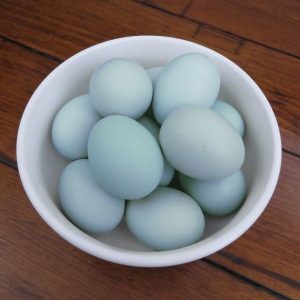
What Color eggs do Ameraucana chickens lay?
Eggs range in color from light blue, pinkish to light green
Production per year
180 to 200 eggs per year
When do Ameraucana chickens start to lay eggs?
Ameraucana chickens start to lay eggs from 6 months old [24 weeks]
Americana Characteristics
Temperament – are they good as pets?
These are a medium-sized bird who are noted for being relatively docile and friendly. However, like any chicken breed they can become competitive and squabble if food or space is in short supply.
Bantam sized birds are currently the most popular with backyard breeders and make excellent pets. Large sized birds can live for up to 8 years; as with most breeds of chicken their egg production declines with age.
How do I tame Ameraucana chickens?
The best way to tame a chicken is to handle it when it is still young; this gets your chickens used to people. If you have older chickens that need taming, try feeding them out of your hand regularly.
How many do I need to buy?
3 chickens is the absolute minimum you need for a flock, we recommend around 5 as a small flock number. An ideal ratio is one cockerel to 9 hens.
How much space do they need?
As these are medium sized birds, ideally 4 square feet per mature bird in a coop. In a run around 15 square feet minimum per bird. Ameraucanas love to be outside foraging for food. Ameraucanas will fly if in danger or suddenly disturbed, so high-level containment fencing above 6 feet (182 cms) is necessary. Some backyard flocks are kept in large sheds, rather like turkey flocks.
Will they mix with my other chickens?
In general Ameraucanas get along well with other breeds of chickens, but if bullied by other more aggressive birds they will stand their ground and defend themselves. Ameraucanas and Bantams will get along fine, as long as they are not too closely confined and there is adequate room for the Bantams to get out from under foot of the larger birds.
Appearance
The most popular colors of Ameraucana are blue wheaten, black & wheaten.
Adult Ameraucana Chickens are medium sized birds available with the following feather coloring:
~ Black
~ Blue
~ Blue Wheaten
~ Mahogany Brown Red
~ Buff
~ Self Blue (sometimes called Lavender)
~White
~ Silver
~ Wheaten
~ Splash (color not recognised by the American Poultry Association)
The beak is horn to dark horn and eyes are reddish brown. Shanks are usually slate blue or blue/green/black with white toes and white bottoms of feet. Beards, tails and ‘muffs’can vary in length, with some birds having their face almost hidden by their muffs. Feather coloring in chicks is sometimes hard to discern and may not be clearly defined until they are a few months months old.
The color of the skin is white. The pea comb, wattles and earlobes are all very small and bright red in color. Wattles may be absent.
Feeding
What should I feed them?
When you first get your chickens home you should feed them growers mash, as it has a higher percentage of protein (19%) and is refined so that it can be easily ingested. You should feed them growers mash up until 6 weeks. At 6 weeks they should be fed chicken pellets which is just feed in pellet form. This has between 15-16% protein.
At 18 weeks your chickens need more nutrients to help with egg production so slowly start feeding them layers mash or pellets which has around 16% protein.
Chickens will need access to fresh drinking water all day long, they will prefer cool drinking water, no one is quite sure why maybe it’s a prehistoric throwback. As Ameraucanas are medium sized birds it is important to have the feed and water at the proper height for all birds in the pen.
Ideally feed and water should be at back level. If the water is too low down, in order to accommodate bantams, Ameraucanas may scratch litter into it and the water will go bad quickly. Your chickens also need grit to help with egg production, so make sure there is always some within easy access to them at all times.
How much should I feed them?
Ameraucana Chickens are active and hungry birds, but you cannot force feed them to accelerate growth when young; you have to patiently build the frame first and then put weight on using top quality feed. They will eat anywhere between 2.5 oz (70g) and 4.5 oz (127g) a day, but on average breeders feed their chickens 3.5 oz (99g) a day.
Start by feeding them this and then adjust the weight of feed around how much they consume. You can leave the feed in a feeder for them to eat whenever they please or you can give them set meal times. Ameraucana Chickens love to forage outside for grubs, green shoots, seeds and bugs.
Your chickens also need grit to help with egg production, so make sure there is always some easily accessible to them at all times.
What can’t they eat?
Chocolate and beans are the two main foods that shouldn’t be eaten by chickens. The phytohemagglutinin in beans can lead to fatalities and the theobromine in chocolate can cause heart problems. Moldy food that has bad bacteria in it should not be fed to chickens as it can make them very unwell. For this reason, it is illegal to feed your chickens leftovers in the UK.
What do I need to keep Ameraucana?
The most essential item you need to keep chickens is a coop, which should ideally be .37 m2 or 4 square feet per chicken. Their run needs 15 square feet per chicken. In the coop they should have a perch to sleep on and a wooden laying box for their eggs. Ameraucanas need enough ‘uncrowded’ space to perch comfortably. As an unhappy and stressed chicken won’t lay many eggs and will be more prone to squabbling with other members of the flock.
An ideal minimum perch height for Ameraucana chickens is 4 feet (1.2 metres) off the ground, to enable the birds to feel safe and secure.
You should invest in a sunken fence to go over and around the coop to keep them safe at night. Find a water bowl which they can’t stand in or push over and place it in the shade, so the water doesn’t get too warm. Feed and water for Ameraucana Chickens are best placed off the ground, at around the ‘back’ height of the bird. Raised feed and water bowl holders are easily obtained.
Ameraucana Chickens For Sale
Try a hatchery called ‘Cackle’ they have best hatching eggs and will ship day old chicks in the post anywhere in the US. The benefit of using a 90 year old family ran business is they have the best quality available rather than trying to find Ameraucana chickens for sale on say; Craigslist. Cackle Hatchery even sell adult Ameraucana chickens, ready to start laying, check them out for yourself.


